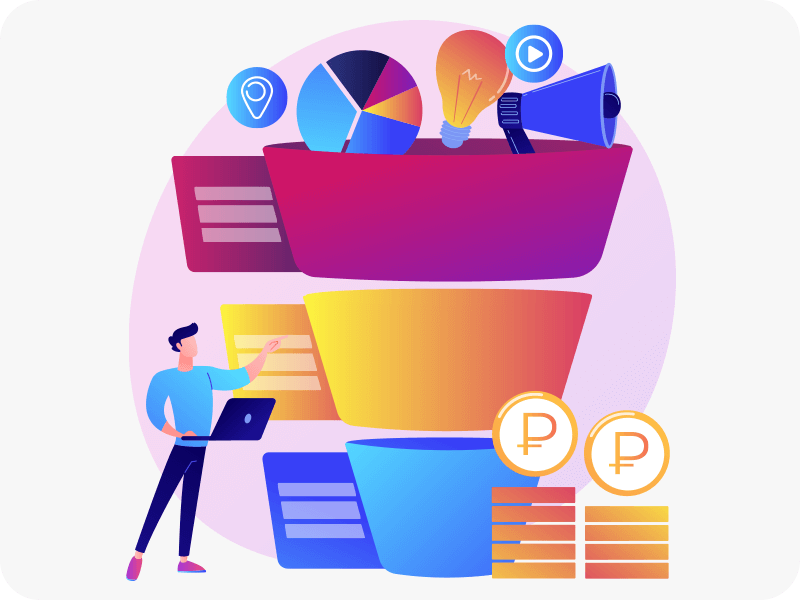Sales funnel
The sales funnel is a marketing tool that allows businesses to attract customers and increase profits. We tell you what it is and how to use the funnel to optimize the sales process.
What is a sales funnel
It is a marketing model of consumer behavior. The concept of the sales funnel is based on the AIDA scheme, according to which any transaction - the sale of goods or services - goes through the same stages.
1. Familiarization with the brand: a potential client sees the advertising offer, pays attention to the product.
2. Interest: shows interest in the product, imagines how he/she will use it.
3. Desire: wants to buy the product.
4. Action: goes to the store or visits the company's website.
This scheme is aimed at an audience that is not yet familiar with the brand. Your task as a salesperson is to make a person aware of the existence of the product and want to buy it. To do this, you need to organize a short path along which the potential buyer will pass from the first contact with the company to the transaction.

With proper marketing, the sales funnel becomes a kind of road map. Each next stage of the journey should warm up potential customers more and more: increase interest, strengthen the desire to buy the product. Consequently, the sales funnel plays an important role in business: this tool influences the behavior of the target audience, persuades, pushes, builds a relationship with the client.
How the sales funnel works
It is based on the principle of an inverted pyramid. You capture a huge audience through the wide base of the funnel, but gradually people drop out, and a relatively small percentage reaches the narrow top, i.e. sales or transactions. Let's look at an example of what this process might look like:
- You run an advertisement on the Internet about the services of a nutritionist. It was seen by 10,000 people.
- Of those, 4,000 potential customers clicked on the expert's profile.
- Next, 2,000 users signed up for an account to read useful information for free.
- Only 20 people left a request to buy the main product - the expert's consultation.
Each step in the sales funnel should be simple, yet push the person to move on to the next step:
- in the promotional offer, encourage people to visit the blog;
- in the blog - to subscribe, read posts;
- in the posts - to sign up for an individual consultation.
There are no specific numbers that speak to the effectiveness of a sales funnel. For example, you can't conclude whether a funnel is effective by the number of days from subscribing to a blog to buying a consultation. Sometimes people read an expert for a long time and only after several years decide to become a client. And some people continue to consume free content without taking a targeted action.
The effectiveness of the sales funnel should be evaluated with the specifics of the business in mind. The region, product category, and average check are all important. There are areas in which even one sale is considered a success.

How to build a sales funnel
First, you need to visualize the entire customer journey and break down the process into steps. For example:
- A user has read a text on a blog.
- He left his contacts to receive notifications about new articles. The data was entered into the CRM and the database for mailings.
- The user received an offer to participate in a webinar as part of an email newsletter.
- At the webinar, he learned more about the company's products.
- Realized that he had a problem that could be solved with one of the products.
- The user placed an order.
As you work on your funnel structure, highlight the stages where you're more likely to lose customers. For example:
- email marketing is ineffective - so the problem occurs at the third step of the funnel;
- managers do not bring communication to the point of sale - so you need to train your employees to close deals (the last step of the funnel).
There should be several sales funnels: one for each channel, product, and segment of the target audience.
Next, transfer all the steps of the sales funnel into a CRM or other program. In doing so, follow two rules:
- each stage of the sales funnel should have clear boundaries that are marked by a specific action: a change in the status of a deal, a transfer to another department - for example, from marketing to sales managers;
- all stages should be measurable and digitized: to analyze the sales funnel, it is necessary to understand how many deals each stage brings and what its conversion rate is.
The total conversion rate of the sales funnel is calculated by the formula: results of the last stage / results of the first stage.
You can take any parameter for the results: for example, the number of users who went to the site and the number of users who reached the last stage of the funnel.
Conversion of one stage of the sales funnel is calculated according to the formula: result of this stage / result of the previous stage.
As you move down the funnel, the conversion rate of each stage should increase. This means that the conversion rate of the second stage should be higher than the first, and the highest rate should be at the last stage of the funnel.
Sales funnel conversion optimization
After building your sales funnel, you need to accumulate statistics. Then, based on information from CRM or other channels, calculate conversion rates and analyze how effective your funnel is. Pay attention to the following metrics:
- How many and what kind of people your content attracts;
- how much your audience trusts you, whether they leave their contacts;
- what other channels customers come through, in what quantity;
- whether customers come back for a second purchase, whether they bring their friends.
After a detailed analysis, you'll find weaknesses and understand what you need to change to improve the effectiveness of each stage of the funnel.
To increase the conversion rate of your sales funnel, you can do the following:
- try to partially or completely replace the content - to do this, study the audience, their needs, interests, problems;
- check whether the title of the ad corresponds to the content of the text you are leading the audience to;
- change the bonuses, for example, instead of a discount, offer free shipping;
- Use different channels to engage your audience;
- Limit the time of purchase or the quantity of goods, artificially creating a shortage.
As you implement each element, track how your audience responds and how your sales funnel conversion rate changes.
Sber's solutions for working with the sales funnel
It's not enough to attract customers to your site with an interesting offer. They still need to be retained and brought to purchase. Often managers are not able to cover a large flow of requests. Especially today, when, in addition to the website, there are social networks, messengers and other communication channels. In order not to lose potential customers at different channels and stages of the funnel, it is worth automating part of the customer journey. Sometimes the implementation of just one solution increases the efficiency of the entire funnel many times over.
Chat-bot
SaluteBot allows you to retain customers at all stages of the sales funnel. With the help of a chatbot you can automate communication with your audience in online channels:
- на сайте;
- в Telegram, Viber;
- в ОК, ВКонтакте;
- на Авито.
SaluteBot responds to a client's message in two seconds, reacts to 100% of messages and processes up to 70% of typical requests on its own. The remaining 30% are complex cases that the bot passes on to managers.
Record badge
SmartBadge from Sbera is a smart device for recording and analyzing conversations with clients. It can be used to assess the quality of consultations, improve service and, consequently, funnel conversion.
SmartBadge will be useful in situations where you need to:
- Improve sales effectiveness;
- resolve a conflict situation with a client;
- pump up the skills of managers and train new employees.
Object Recognition
Layer by Sber is a service for recognizing objects, locations and people in the frame and on photos. The system will be useful for both businesses and their clients.
Business Value:
- unique API with image recognition technology allows you to solve various marketing tasks;
- the service's capabilities help guide the audience through the sales funnel: if a user wants to buy a product like in the movie, the system will offer to do it in your store.
Value to customers:
- the opportunity to learn about objects and places in the frame without taking your eyes off the viewer;
- an opportunity to buy a favorite item or tickets to a favorite place.
Neural networks analyze photos and videos using their own unique algorithm. The collected data is available immediately in the system administrator panel. In addition, monetization mechanisms are built into the service.
Salute Screens
Digital screens help businesses attract the attention of new customers and retain old ones. They are electronic platforms for advertising in public places.
For example, with the help of Salute Screens you can tell about the company, promotions, new products, seasonal offers.
More on the screens can be placed important information that needs to be conveyed to visitors to the store or shopping center.
Effectiveness of Salute Screens:
- 83% higher memorization rate compared to a static image;
- 47% higher brand awareness with digital signage.
You can manage your content in your online cabinet. Here you have access to editing your offer in real time and convenient customization of its display. Statistics will help you analyze the result of your advertising campaign.
Salute Hotel
The interactive solution helps to create a more comfortable environment for hotel guests. Integration with PMS systems allows you to place all the necessary media services on one screen to make you feel at home.
Opportunities Salute Hotel:
- video and TV: familiar TV channels and videos of your favorite bloggers;
- movies and music: more than 60 million tracks in the catalog, as well as a collection of movies and TV series;
- virtual assistant: information on hotel services.
Salut Hotel's interactive solution is a way to communicate about the hotel in a more engaging way. In addition, digital advertising reduces the company's printing costs. The service works on SberBox, SberPortal and Sber TVs.



